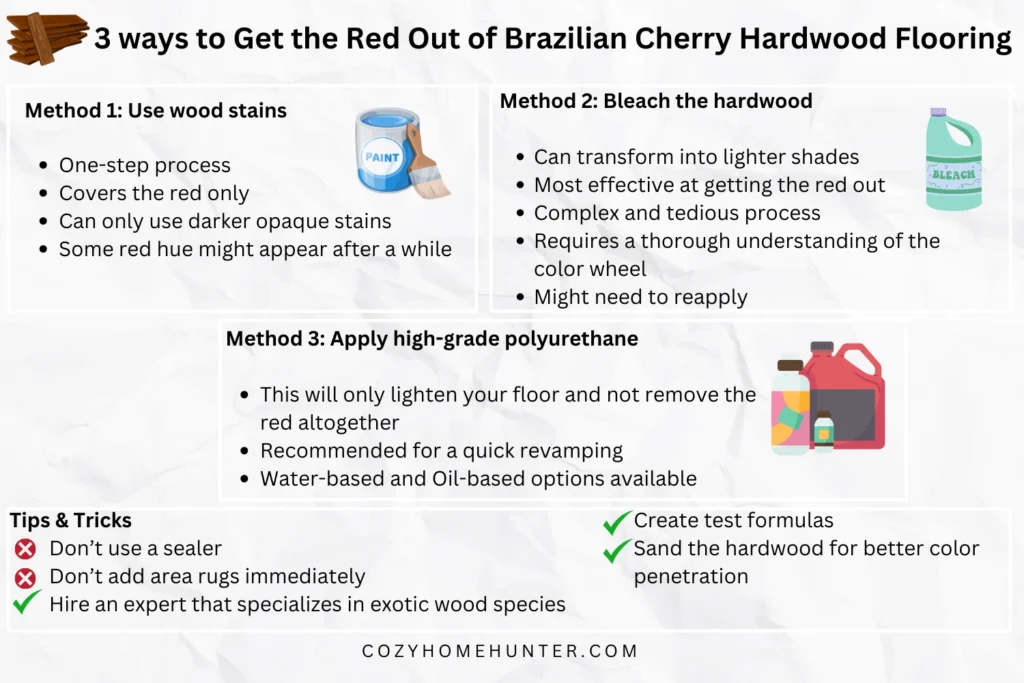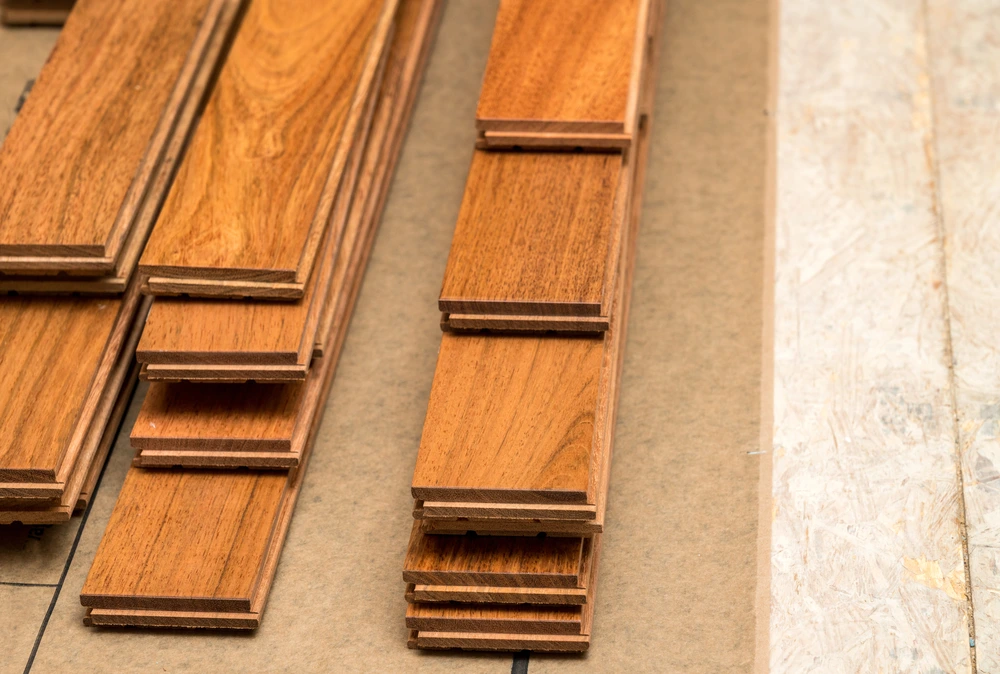
Is your Brazilian cherry hardwood looking a little out of space, out of style? Red floors are not really in right now as they were in the early 2000s. And if you have grown out of the bright red hardwood, don’t worry. You don’t have to stick with them forever!
You have three options to eliminate the red from Brazilian cherry hardwood: using wood stains to go to a darker color, bleaching the hardwood to reach cool lighter tones, and applying a high-grade polyurethane. Sanding or refinishing won’t eliminate the red or cherry tones, as the natural tone goes all the way through.
From sanding to staining, let’s give your Brazilian cherry hardwood a makeover it desperately needs. And did we mention we’ll reveal some top-secret trade tips along the way? Let’s get started!
Table of Contents
Basics of Brazilian Cherry Hardwood

Before you start dying or bleaching your hardwood, you need to know the basics of Brazilian cherry hardwood to familiarize yourself with the nitty and gritty of what you’re dealing with here.
So, what is Brazilian cherry hardwood?
Hailing all the way from the rainforest of Brazil, the Brazilian cherry is known for its iconic cherry shade. It is commonly known as jatoba. Often confused with the American cherry, the Brazilian cherry is darker and much tougher than its northern counterpart. Brazilian cherry scores an astounding Janka hardwood rating of 2350.
The iconic red tone is natural to Brazilian cherry and goes all the way through. So, there is no point trying to sand it away. As soon as the new wood gets exposed to UV, it turns red, purple or pink, just like the older wood. But there is good news: Jatoba is very receptive to finishes and stains. And its tough exterior protects it from damage due to harsh chemicals such as bleach.
Brazilian cherry has loads of variations for you, including solid, engineered, prefinished, unfinished, and hand-scraped. You need to learn about the finishes and types of your floor before attempting to remove the red or cherry tone from it.
How much does Brazilian cherry hardwood cost?
The price of Brazilian cherry hardwood depends on the variation. The average cost of prefinished Brazilian cherry stands at $5.50 per square foot, while the unfinished ones will cost you $4.75 to $5 per square foot on average. You can also get engineered prefinished Brazilian cherry at $4.49 per square foot.
How to Get Rid of Red Tones in Brazilian Cherry Hardwood
Understanding the Color Wheel

A color wheel is an excellent tool when you’re trying to change an existing color. Red, yellow and blue are the three primary colors, and their complementary colors are green, purple, and orange, consecutively. The complementary color will “cancel out” the primary color, so they sit opposite each other on the color wheel. This theory will help you conceal the existing color without using an excessive amount of product.
As you can see from the color wheel, green sits opposite to red. So, to transform Brazilian cherry, you need to use green to cancel out red. You can find green stains on its own. But if you’re using stains only offering primary colors, you can mix blue and yellow in appropriate ratios to get the desired color.
Use wood stains
This is an easy yet effective one-step process to “remove” the red from Brazilian cherry. Now keep in mind that the stain won’t remove or eliminate anything but will simply cover it. So, you can only go to darker colors using an opaque stain. The darker the stain, the less red you’ll see.
To cover up the red in your hardwood, you need to use darker stains than your floor. Dark walnut and ebony shades are decent choices for this job. However, don’t expect your hardwood to come out the exact shade as the stain. The final color depends on how the wood reacts with the stain. And some red hue might reappear over time—especially with water-based stains.
You can also go for pure black shades as well. This will do an impeccable job of hiding the red. However, darker hardwoods can be more challenging to maintain as they show dust and dirt more pronounced. But you won’t risk the red peaking through after a while. Another good option to remove the red from Brazilian cherry hardwood is mixing black stains with walnut stains. The proportion you use is entirely up to the end results you are looking for.
Bleach the hardwood
You probably saw this coming—but yes, we’ll bleach the hardwood to eliminate the red in the Brazilian cherry. Although bleaching wood is more of the expert forte, it also allows you to transform it into lighter shades. It will wash away most of the red from the cherry. However, some red might still peak in, making the wood look pinkish. Also, keep in mind that this is a multiple-day process, and you will be dealing with hazardous chemicals. So, you should have a secondary residence arranged if you’re dealing with the flooring of your entire house.
Before bleaching the hardwood, let’s go back to the color wheel. As we already know, green cancels red; use that to your advantage to lift the red even more. You will need to mix these according to the specific product you’re using—and this is where experience and expertise matter because it’s really tough to guesstimate the green color to bleach ratio to create your desired results.
You might need to apply the bleach multiple times depending on how light you want to go. You also need to sand the floor before bleaching. Let the wood rest for at least 20 minutes before reapplication. Also, don’t let the bleach pool too much, as it can break down the cells of hardwood. After the final bleach, let the hardwood sit for 24 hours before washing the floor to neutralize the bleach. Afterwards, you can apply your stain and reseal the floor. (Read more on resealing in the do’s and don’ts section.)
Apply high-grade polyurethane
Applying a high-grade polyurethane can help significantly lighten the red of your Brazilian cherry hardwood floors. This will only lighten your floor and not remove the red altogether. We recommend this method to those who need a quick revamping of their cherry floors but don’t want to deal with bleaches and stains. Polyurethanes are also very basic to apply and do not require much expertise.
With polyurethane, you have two main options: water-based and oil-based. Although both are decent choices, you might lean towards one more than the other. For example, oil-based polyurethane creates a harder shell on the floor, lasts longer, and protects the floor from scratches. However, it takes longer to cure and might darken or get yellowish over time.
On the other hand, water-based polyurethanes are lighter, look more natural, and are easier to deal with. However, since it is water-based, it will wash away if you clean your floors with water. They are also less durable against scratches and might need to be reapplied more often.
Do’s & Don’ts of Getting Rid of Red From Brazilian Cherry Hardwood
Now that we know how to eliminate the red from Brazilian cherry hardwood let’s give you a few heads up for your project.
1. Don’t use a sealer
This is a common mistake made by those who aren’t familiar with the properties of the exotic species on their hands. Brazilian cherry is a particularly oily wood that might react to the sealer. If it does, you will be left with bubbles and white patches all over the floor. You are better off using wood oil to finish the floor.
2. Don’t add area rugs immediately
Typically, most naturally dyed wood species react with the light and change their color. Exposure to natural and artificial lights causes the wood to redden and darken over time. Most of this process occurs in the first 6 months after refinishing as the wood settles to its final color. So, avoid placing area rugs in that period to avoid getting different tones in different parts of the floor.
3. Hire an expert that specializes in exotic wood species
If you’re working with an expert, it is crucial that they have experience working with exotic wood species. Because otherwise, you will have to pay dearly for any mistake they make. The property of these woods heavily dictates how much you can sand, what stain or sealer you can apply, and any other chemicals you use on it.
4. Create test formulas
When bleaching or staining the floor, don’t just guesstimate the ratios of dyes. Create test formulas, apply them to an extra plank or in a discrete corner of the floor, and observe how it reacts. You should wait for a few days to determine if the test formula is good to go, as there might be a delayed reaction from the wood.
5. Sand the hardwood for better color penetration
Sanding a floor determines if more or less pigment will penetrate the wood. When it comes to Brazilian cherry or other exotic species, we recommend consulting an expert on how much you can sand without damaging the wood. Sanding the wood also removes stains and oil from the top and helps water-based products penetrate deeper. You might want to avoid sanding if you want the dye to sit on top of the wood rather than going deeper.
Do you have any questions on how to get the red out of Brazilian cherry hardwood? Comment below and let us know!





